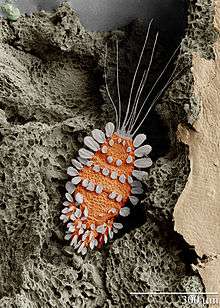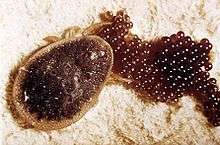Acari
The Acari /ˈækəraɪ/ (or Acarina /ækəˈraɪnə/) are a taxon of arachnids that contains mites and ticks. The diversity of the Acari is extraordinary and their fossil history goes back to at least the early Devonian period.[1] Acarologists (people who study the Acari) have proposed a complex set of taxonomic ranks to classify mites. In most modern treatments, the Acari are considered a subclass of the Arachnida and are composed of two or three superorders or orders: Acariformes (or Actinotrichida), Parasitiformes (or Anactinotrichida), and Opilioacariformes; the latter is often considered a subgroup within the Parasitiformes. The monophyly of the Acari is open to debate, and the relationships of the acarines to other arachnids is not at all clear.[2] In older treatments, the subgroups of the Acarina were placed at order rank, but as their own subdivisions have become better understood, treating them at the superorder rank is more usual.
| Acari | |
|---|---|
 | |
| Peacock mite (Tuckerella sp.), false-colour SEM, magnified 260× | |
| Scientific classification | |
| Kingdom: | Animalia |
| Phylum: | Arthropoda |
| Subphylum: | Chelicerata |
| Class: | Arachnida |
| Subclass: | Acari Leach, 1817 |
| Superorders | |
|
and see text | |
Most acarines are minute to small (for example, 0.08–1.00 mm or 0.003–0.039 in), but the largest (some ticks and red velvet mites) may reach lengths of 10–20 mm (0.4–0.8 in). Over 50,000 species have been described (as of 1999) and an estimated million or more species may exist. The study of mites and ticks is called acarology (from Greek ἀκαρί/ἄκαρι, akari, a type of mite; and -λογία, -logia),[3] and the leading scientific journals for acarology include Acarologia, Experimental and Applied Acarology and the International Journal of Acarology.
Morphology
Mites are arachnids, and as such, evolved from a segmented body with the segments organised into two tagmata: a prosoma (cephalothorax) and an opisthosoma (abdomen). However, only the faintest traces of primary segmentation remain in mites; the prosoma and opisthosoma are fused, and a region of flexible cuticle (the circumcapitular furrow) separates the chelicerae and pedipalps from the rest of the body. This anterior body region is called the capitulum or gnathosoma, and according to some works, is also found in the Ricinulei. The remainder of the body is called the idiosoma and is unique to mites.
Most adult mites have four pairs of legs, like other arachnids, but some have fewer. For example, gall mites like Phyllocoptes variabilis (family Eriophyidae) have a worm-like body with only two pairs of legs; some parasitic mites have only one or three pairs of legs in the adult stage. Larval and prelarval stages have a maximum of three pairs of legs; adult mites with only three pairs of legs may be called 'larviform'. Also, members of the Nematalycidae within the Endeostigmata, which live between sand grains, have often worm-like and elongated bodies with reduced legs.[4]
The mouth parts of mites may be adapted for biting, stinging, sawing, or sucking. They breathe through tracheae, stigmata (small openings of the skin), intestines, and the skin itself. Species hunting for other mites have very acute senses, but many mites are eyeless. The central eyes of arachnids are always missing, or they are fused into a single eye. Thus, any eye number from none to five may occur.[5]
Ontogeny


Acarine ontogeny typically consists of an egg, a prelarval stage (often absent), a larval stage (hexapod except in the mite superfamily Eriophyoidea, which have only two pairs of legs), and a series of nymphal stages. Any or all of these stages except the adult may be suppressed or occur only within the body of a previous stage. Larvae (and prelarvae) have a maximum of three pairs of legs (legs are often reduced to stubs or absent in prelarvae); legs IV are added at the first nymphal stage. Usually, a maximum of three nymphal stages are present and they are referred to in sequence as the protonymph, deutonymph, and tritonymph; however, some soft ticks have supernumerary nymphal stages. The females of some Tarsonemidae bear sexually mature young. If any nymphal stages are absent, then authors may disagree on which stages are present. Only the Oribatida pass through all developmental stages.[5]
Diversity and lifestyles
Acarines are extremely diverse. They live in practically every habitat, and include aquatic (fresh and sea water) and terrestrial species. They outnumber other arthropods in the soil organic matter and detritus. Many are parasitic, and they affect both vertebrates and invertebrates. Most parasitic forms are external parasites, while the free-living forms are generally predatory and may even be used to control undesirable arthropods. Others are detritivores that help to break down forest litter and dead organic matter, such as skin cells. Others still are plant feeders and may damage crops.
The feather mites, Astigmata, are found on almost all species of birds, except for penguins, and are highly specialized for life on their hosts. They may feed on uropygial oil, skin flakes, fungus, bacteria, and feathers, depending on the taxon to which they belong. Their lifestyles are affected by the microclimate (ambient temperature and relative humidity); for example, seasonal change in temperature causes feather mites to shift their microhabitats on blue tits. However, no evidence shows microclimate affecting mite diversity.[6]
Economic and medical importance
.jpg)
Damage to crops is perhaps the most costly economic effect of mites, especially by the spider mites and their relatives (Tetranychoidea), earth mites (Penthaleidae), thread-footed mites (Tarsonemidae) and the gall and rust mites (Eriophyidae). The honey bee parasite Varroa destructor has caused or contributed to large-scale die-offs of commercial pollinating populations.[7]
Some parasitic forms affect humans and other mammals, causing damage by their feeding, and can even be vectors of diseases, such as scrub typhus, rickettsialpox, Lyme disease, Q fever, Colorado tick fever, tularemia, tick-borne relapsing fever, babesiosis, ehrlichiosis, and tick-borne meningoencephalitis.[8] A well-known effect of mites on humans is their role as allergens and the stimulation of asthma in people affected by respiratory disease.
The use of predatory mites (for example, Phytoseiidae) in pest control and herbivorous mites that infest weeds are also of importance. An unquantified, but major positive contribution of the Acari is their normal functioning in ecosystems, especially their roles in the decomposer subsystem.[3] In this context, the association of many species with carcasses and decaying organic matter qualify them as potential medicolegal indicators in forensic entomology.[9]
Chemical agents used to control ticks and mites include dusting sulfur and ivermectin.
Taxonomy and phylogeny


The phylogeny of the Acari is still disputed and several taxonomic schemes have been proposed for their classification. The third edition (2009) of the standard textbook A Manual of Acarology uses a system of six orders, grouped into three superorders:[10]
- Superorder Opilioacariformes – mites that superficially resemble harvestmen (Opiliones), hence their name
- Superorder Parasitiformes – ticks and a variety of mites
- Holothyrida
- Ixodida – ticks
- Mesostigmata – bird mites, phytoseiid mites, Raubmilben
- Trigynaspida
- Monogynaspida
- Superorder Acariformes – the most diverse group of mites
- Trombidiformes – plant parasitic mites (spider mites, peacock mites, gall mites, red-legged earth mites, etc.), snout mites, chiggers, hair follicle mites, velvet mites, water mites, etc.
- Sarcoptiformes
Recent genetic research has caused a change in the naming scheme, however, and recent publications have changed the superorder Parasitiformes to an order.[11] Other recent research has suggested that Acari is polyphyletic, with ticks and spiders being more closely related than ticks and mites.[12] The cladogram is based on Dabert et al. 2010, which used molecular data. It showed the Acariformes sister to the Solifugae (camel spiders), while the Parasitiformes were sister to the Pseudoscorpionida.[13]
|
"Acari" (mites and ticks) |
See also
References
- Walter, David Evans; Krantz, Gerald; Lindquist, Evert (December 13, 1996). "Acari. The Mites". Tree of Life Web Project. Retrieved June 21, 2010.
- Garwood, Russell J.; Dunlop, Jason A. (2014). "Three-dimensional reconstruction and the phylogeny of extinct chelicerate orders". PeerJ. 2: e641. doi:10.7717/peerj.641. PMC 4232842. PMID 25405073.
- Walter, D. E.; Proctor, H. C. (1999). Mites: Ecology, Evolution and Behaviour. University of NSW Press, Sydney and CABI, Wallingford. ISBN 978-0-86840-529-2.
- "Of Knots & Worms Not: Gordialycus". macromite.wordpress.com. May 23, 2010. Retrieved October 31, 2017.
- Schmidt, Günther (1993). Giftige und gefährliche Spinnentiere (in German). Westarp Wissenschaften. pp. 58ff. ISBN 978-3-89432-405-6.
- Villa, Scott M; Bohec, Celine Le (October 2013). "Diversity of Feather Mites (Acari: Astigmata) on Darwin's Finches". The Journal of Parasitology. 99 (5): 756–762. doi:10.1645/12-112.1. PMC 4098782. PMID 23691947.
- Potts, Simon G.; Biesmeijer, Jacobus C.; Kremen, Claire; Neumann, Peter; Schweiger, Oliver; Kunin, William E. (2010-06-01). "Global pollinator declines: trends, impacts and drivers". Trends in Ecology & Evolution. 25 (6): 345–353. CiteSeerX 10.1.1.693.292. doi:10.1016/j.tree.2010.01.007. PMID 20188434.
- "Managing Common Tick Pests in Los Angeles County" (PDF). Vector Management Program, Department of Health Services, Los Angeles County, California. Retrieved May 20, 2009.
- González Medina, A; González Herrera, L; Perotti, MA; Jiménez Ríos, G (2013). "Occurrence of Poecilochirus austroasiaticus (Acari: Parasitidae) in forensic autopsies and its application on postmortem interval estimation". Exp. Appl. Acarol. 59 (3): 297–305. doi:10.1007/s10493-012-9606-1. PMID 22914911.
- Krantz, Gerald W.; Walter, D. E., eds. (2009). A Manual of Acarology (3rd ed.). Texas Tech University Press. ISBN 978-0-89672-620-8.
- Barker, S.C. & Murrell, A. (2004). "Systematics and evolution of ticks with a list of valid genus and species names". Parasitology. 129 (7): S15–S36. doi:10.1017/S0031182004005207. PMID 15938503.
- Sanggaard, Kristian W.; Bechsgaard, Jesper S.; Fang, Xiaodong (6 May 2014). "Spider genomes provide insight into composition and evolution of venom and silk". Nature Communications. 5: 3765. Bibcode:2014NatCo...5.3765S. doi:10.1038/ncomms4765. ISSN 2041-1723. PMC 4273655. PMID 24801114.
- Dabert, Miroslawa; Witalinski, Wojciech; Kazmierski, Andrzej; Olszanowski, Ziemowit; Dabert, Jacek (2010). "Molecular phylogeny of acariform mites (Acari, Arachnida): Strong conflict between phylogenetic signal and long-branch attraction artifacts". Molecular Phylogenetics and Evolution. 56 (1): 222–241. doi:10.1016/j.ympev.2009.12.020. ISSN 1055-7903. PMID 20060051.
Further reading
- Niedbala, Wojciech (1992). Phthiracaroidea (Acari, Oribatida): Systematic Studies. Warsaw: PWN, Amsterdam: Elsevier. ISBN 978-8-301-09740-0.
- Experimental and Applied Acarology, ISSN 1572-9702 (electronic) ISSN 0168-8162 (paper), Springer
- Baker, E. (1952). An Introduction to Acarology. New York: The MacMillan Company.
- Woolley, T. (1988). Acarology: Mites and Human Welfare. New York: Wiley Interscience. ISBN 978-0-471-04168-9.
- Halliday, R. B.; Walter, D. E.; Proctor, H. C.; Norton, R. A.; Colloff, M. J. (2001). Acarology, Proceedings of the 10th International Congress [5–10 July 1998]. Collingwood, Victoria: CSIRO Publishing, Melbourne. pp. 960 pp. ISBN 978-0-643-06658-8.
- Walter, D. E.; Proctor, H. C. (2001). Mites in soil, an interactive key to mites and other soil microarthropods. ABRS Identification Series, CSIRO Publishing, Collingwood, Victoria.
- Krantz, Gerald W.; Walter, D. E., eds. (2009). A Manual of Acarology (3rd ed.). Texas Tech University Press. ISBN 978-0-89672-620-8.
External links
| Wikimedia Commons has media related to Acari. |
| Wikispecies has information related to Acari |
| The Wikibook Dichotomous Key has a page on the topic of: Acari |
- Tree of Life Web Project
- Walter, David Evans; Krantz, Gerald; Lindquist, Evert (December 13, 1996). "Acari. The Mites". tolweb.org. Tree of Life Web Project.
- Proctor, Heather (August 9, 1998). "Acariformes. The "mite-like" mites". tolweb.org. Tree of Life Web Project.
- Walter, David Evans (December 13, 1996). "Parasitiformes. Holothyrans, ticks and mesostigmatic mites". tolweb.org. Tree of Life Web Project.
- Harvey, Mark; Proctor, Heather. "Key to Families and Subfamilies of Water Mites (Hydracarina) in Australia". lucidcentral.com. Archived from the original on 2006-08-25.
- Walter, David Evans (September 15, 2006). "Invasive Mite Identification". lucidcentral.org. Colorado State University, USDA/APHIS/PPQ Center for Plant Health Science and Technology. Archived from the original on March 13, 2007.
- Non-invasive 3D-visualization with sub-micron resolution using synchrotron-X-ray-tomography, jove.com
.jpg)

